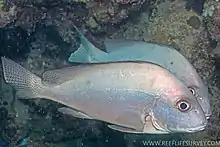| Diagramma labiosum | |
|---|---|
 | |
| Scientific classification | |
| Domain: | Eukaryota |
| Kingdom: | Animalia |
| Phylum: | Chordata |
| Class: | Actinopterygii |
| Order: | Perciformes |
| Family: | Haemulidae |
| Genus: | Diagramma |
| Species: | D. labiosum |
| Binomial name | |
| Diagramma labiosum Macleay, 1883 | |
Diagramma centurio, the painted sweetlips,[2] Australian slatey, greysweetlips, painted blubber-lips or yellowdot sweetlips,[3] is a species of marine ray-finned fish, a sweetlips belonging to the family Haemulidae. It is found in the Indo-Pacific region.[4]
Description
Diagramma labiosum has fleshy lips that become more swollen as the fish matures. The chin has six pores on it but there is no median pit.[5] The dorsal fin contains 9-10 spines and 22-25 soft rays while the anal fin contains 3 spines and 7 soft rays.[4] It is slate-grey in colour, the adults and subadults being unmarked unlike the spotted, parapatric painted sweetlips (D. pictum).[3] The juveniles are dark brown to black dorsally, split into 3 or more wide horizontal stripes by narrower whitish-blue stripes; they silvery yellow ventrally. The dorsal and caudal fins are yellow with black blotches and discontinuous stripes which grow with age and fragment into small circular spots before fading away in adults.[5] As the fish matures from a juvenile to an adult the caudal fin form changes from being rounded to truncate. This species attains a maximum recorded total length of 90 cm (35 in) and a maximum published weight of 6.3 kg (14 lb).[4]
Distribution
Diagramma labiosum is found in the eastern Indian Ocean and southwestern Pacific Ocean. Its range encompasses southern New Guinea and northern Australia.[1] In Australia its range extends from the Houtman Abrolhos Islands in Western Australia to Sydney, including Lord Howe Island in the Tasman Sea.[3]
Habitat and biology
Diagramma labiosum is found at depths between 10 and 20 m (33 and 66 ft) over soft substrates within sea grass beds, mangroves and coral reefs.[1] The juveniles are found in estuaries and lagoons. It is found in large schools.[4] It feeds on crustaceans, molluscs, annelids, cephalopods and fishes.[1]
Systematics
Diagramma labiosum Was first formally described in 1883 by the Scottish-born Australian naturalist William John Maclean with the type locality given as Wide Bay in Queensland.[6] This species is regarded as a subspecies of the painted sweetlips (D. pictum) by some authorities,[3] while others also classify Diagramma melanacrum within the same species as D. labiosum and D. pictum, D. pictum.[1] The specific name labiosum means “thick lipped”, referring to the smooth and fleshy lips of this species.[7]
Utilisation
Diagramma labiosum is a common species which is caught using handlines and by spearfishing, the flesh is sold fresh.[5] In Queensland a maximum of 5 per day, in a total reef fish maximum catch of 20 per day, may be taken by recreational fishers.[8]
References
- 1 2 3 4 5 Al Abdali, F.S.H.; Al Buwaiqi, B.; Al Kindi, A.S.M.; Ambuali, A.; Carpenter, K.E.; Borsa, P.; Govender, A.; Russell, B. (2019). "Diagramma labiosum". IUCN Red List of Threatened Species. 2019: e.T123439535A123494867. doi:10.2305/IUCN.UK.2019-2.RLTS.T123439535A123494867.en. Retrieved 20 November 2021.
- ↑ "Painted Sweetlips, Diagramma pictum (Thunberg, 1792)". Australian Museum. Retrieved 16 April 2021.
- 1 2 3 4 Bray, D.J. (2017). "Diagramma pictum labiosum". Fishes of Australia. Museums Victoria. Retrieved 16 Apr 2021.
- 1 2 3 4 Froese, Rainer; Pauly, Daniel (eds.) (2021). "Diagramma labiosum" in FishBase. February 2021 version.
- 1 2 3 R.J. MacKay (2001). "Haemulidae". In Carpenter, K.E. & Neim, Volker H. (eds.). The Living Marine Resources of the Western Central Pacific Volume 5: Bony fishes part 3 (Menidae to Pomacentridae) (PDF). FAO Species Identification Guide for Fishery Purposes. FAO Rome. p. 2983.
- ↑ Eschmeyer, William N.; Fricke, Ron & van der Laan, Richard (eds.). "Species in the genus Diagramma". Catalog of Fishes. California Academy of Sciences. Retrieved 16 April 2021.
- ↑ Christopher Scharpf; Kenneth J. Lazara, eds. (5 January 2021). "Order LUTJANIFORMES: Families HAEMULIDAE and LUTJANIDAE". The ETYFish Project Fish Name Etymology Database. Christopher Scharpf and Kenneth J. Lazara. Retrieved 16 April 2021.
- ↑ "Painted Sweetlips". State of Queensland. Retrieved 16 April 2021.
